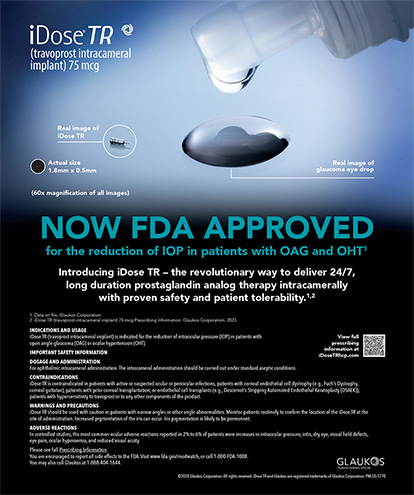
As ophthalmologists, we are fortunate to have access to remarkable technology. Despite our best efforts, however, complications still occur. This article shares how managing complications has profoundly influenced my approach to dealing with unhappy patients.
A Pivotal Moment
I played a role as an original investigator for the excimer laser, approved by the US FDA in 1995. The approval came after 6 years of exhaustive and comprehensive clinical trials. To date, nearly 20 million procedures have been performed in the United States, supported by hundreds of clinical trials. These studies have documented LASIK’s safety and efficacy and highlighted its accuracy and high patient satisfaction rates.
In 2008, in response to 140 complaints, the US FDA conducted a public hearing to assess LASIK’s safety and consider potential constraints on the procedure. About 25 patients who had experienced complications from LASIK were invited to share their experiences with the US FDA panel. As a representative of the ASCRS, I attended to support LASIK.
I anticipated hearing from individuals focused on their complications and how these affected their vision and lives. The reality was strikingly different. A common narrative emerged: After experiencing complications, these patients felt abandoned by their surgeons. The patients reported being told that there was no solution or, worse, that they should be content with their compromised vision. Many sought second opinions, only to find that some practices refused to see patients who had undergone surgery elsewhere.
The hearing was one of the most educational events of my career. It changed my perspective on patient management. Now, I make a conscious effort to ensure no patient feels abandoned after a surgical procedure, whether it was performed by another surgeon or me. I do everything possible to show my concern about their issues. I reinforce our joint commitment to resolve their problem and, if necessary, refer them to a more suitable specialist. To my mind, compassion is essential to our duty as surgeons to our patients.
No surgeon is without a dissatisfied patient. Consistently achieving postoperative satisfaction is a complex process that extends beyond surgical precision. It requires a holistic and preventative approach that starts with a meticulous preoperative evaluation, careful patient selection, thorough patient education, and the setting of realistic expectations.
When an unhappy patient first comes to the office after surgery, the evaluation should be both targeted and comprehensive. Effective communication and counseling are critical. This includes addressing common causes of dissatisfaction, such as misaligned expectations, residual refractive errors, and untreated ocular surface disease.
Critical Factors Influencing Patient Satisfaction
Three primary factors influence patient satisfaction: the health of the eye, the surgical outcome, and patient expectations. Patient satisfaction can be accurately described as the surgical outcome minus patient expectations. Thus, clear communication about preexisting conditions such as ocular surface disease, glaucoma, irregular corneas, and, especially, macular pathology such as epiretinal membranes and macular holes is critical. The following is one of my guiding principles: Identifying pathology before surgery sets an expectation, whereas discovering it after surgery can lead the patient to view it as a complication of the procedure. Specifically, in cataract surgery, patients must understand the following
- Inaccuracies in IOL power calculations and residual astigmatism can occur;
- Additional procedures may be necessary to optimize refractive outcomes;
- There are no guarantees. Complications can arise, and there may be times when the patient will need to wear glasses or contact lenses;
- Glare and halos are possible, and these phenomena are more common when a presbyopia-correcting IOL is implanted; and
- In rare cases, IOL removal may be performed as a last resort.
Strategies for Managing Dissatisfied Patients
When managing dissatisfied patients, I employ three pivotal strategies.
No. 1: Avoid direct confrontation. The first strategy is to prevent patients from expressing dissatisfaction directly to me, their ophthalmologist. Once a patient articulates discontent with their surgeon, the patient-surgeon relationship is often permanently altered or, at a minimum, challenging to restore. Proactive measures are taken to circumvent any form of confrontation.
When a dissatisfied patient visits my office, my team is trained and authorized to conduct the necessary examinations to identify the root of the patient’s dissatisfaction. Testing typically includes a manifest refraction, an ocular surface evaluation, topography, and macular OCT imaging. These patients receive priority scheduling, and I am briefed on their concerns before I meet them in the examination room. I encourage them to bring family members to consultations to foster a supportive environment. To avoid conflict, I begin our discussion by empathizing with their situation, acknowledging that their feelings of dissatisfaction are valid, and stating that I would likely feel similarly if I were in their position. I then swiftly review the findings of the diagnostic tests that pinpoint their issue and promptly offer a solution to address their concerns. I emphasize that our goals are aligned—that we are on the same team—and I commit to collaborating with them to alleviate their concerns. My goals are to prevent a confrontational situation and ensure that the patient does not feel compelled to express dissatisfaction directly to me.
No. 2: Do not demand satisfaction. It is imperative to avoid telling a patient, “You should be satisfied.” A common grievance among patients is being told they should be content based on their Snellen visual acuity alone, without consideration of dysphotopsias, decreased contrast sensitivity, or a reduction in their overall quality of vision. Perception is reality.
No. 3: Skip the bill. In my practice, patients who have chosen a premium service and paid out of pocket are not billed for additional surgical procedures required to rectify a problem.
Empathy and Commitment
The essence of managing unhappy patients is demonstrating empathy and a shared commitment to resolving their dissatisfaction. It is vital for the surgeon to remain approachable, clearly communicate a remedial plan, and, above all, ensure the patient never feels neglected. Although a flawless procedure is ideal, adeptly addressing a complication can be incredibly fulfilling professionally. Witnessing the transformation of an unhappy patient into a satisfied one is a profound endorsement of the physician and can ultimately build the practice.
There are two categories of ophthalmologists: those who encounter complications and those who do not perform surgeries. All surgeons must navigate complications. Their ability to handle these situations with compassion reflects on their character as physicians and influences how their patients perceive them.




